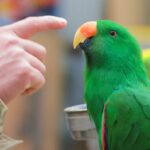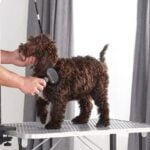Table of Contents
Teaching your dog to shake hands is a fun and rewarding trick that can impress friends and strengthen your bond with your furry friend. This guide provides simple steps on how to teach a dog to shake hands, making the training process easy and enjoyable for both you and your dog. Here are seven easy steps to help your dog learn this charming trick.

1. Start with Basic Commands
Before teaching your dog to shake hands, ensure they have mastered basic commands:
- Sit Command: Teach your dog to sit on command, as this will be the starting position for the shake hands trick.
- Focus: Ensure your dog can focus on you and follow simple instructions.
Having a solid foundation in basic commands makes learning new tricks easier.
2. Prepare Treats and Rewards
Positive reinforcement is crucial for successful training:
- Small Treats: Use small, bite-sized treats that your dog loves to reward them for good behavior.
- Verbal Praise: Pair treats with verbal praise such as “Good job!” or “Well done!” to reinforce the behavior.
Treats and praise motivate your dog to perform the desired action.
3. Get Your Dog into the Sitting Position
Begin the training session by getting your dog into the sitting position:
- Command “Sit”: Use the sit command to get your dog to sit in front of you.
- Focus on You: Ensure your dog is focused on you and ready to follow instructions.
A calm and focused sitting position is the starting point for the shake hands trick.
4. Introduce the “Shake Hands” Command
Introduce the command and action for shaking hands:
- Extend Your Hand: Extend your hand toward your dog’s paw while saying the command “Shake” or “Shake hands.”
- Gently Lift Paw: If your dog does not lift their paw on their own, gently lift their paw and place it in your hand.
- Immediate Reward: Immediately reward your dog with a treat and praise after their paw is in your hand.
Introducing the command and action together helps your dog understand what you are asking them to do.
5. Practice and Repeat
Consistency is key to reinforcing the behavior:
- Short Sessions: Keep training sessions short (5-10 minutes) to maintain your dog’s interest.
- Frequent Practice: Practice the shake hands command several times a day to reinforce learning.
- Positive Reinforcement: Continue to use treats and praise to reward your dog each time they perform the trick correctly.
Regular practice helps solidify the behavior in your dog’s mind.
6. Gradually Reduce Treats
Once your dog consistently performs the trick, gradually reduce the frequency of treats:
- Intermittent Rewards: Start rewarding your dog every other time they perform the trick correctly, then gradually reduce further.
- Verbal Praise: Continue to use verbal praise even when you reduce the treats to maintain positive reinforcement.
- Occasional Treats: Occasionally give a treat to keep your dog motivated and reinforce the behavior.
Gradually reducing treats helps your dog learn to perform the trick without expecting a treat every time.
7. Generalize the Behavior
Teach your dog to perform the trick in various environments and situations:
- Different Locations: Practice the shake hands command in different locations, such as indoors, outdoors, and at the park.
- Various Distractions: Gradually introduce distractions to ensure your dog can perform the trick even when distracted.
- Other People: Have other family members or friends practice the trick with your dog to generalize the behavior.
Generalizing the behavior ensures your dog can perform the trick in any situation.
Conclusion on How to Teach a Dog to Shake Hands
Teaching your dog to shake hands is a fun and rewarding process that strengthens your bond and showcases your dog’s skills. By following these steps on how to teach a dog to shake hands, you can easily train your dog to perform this charming trick. Start with basic commands, prepare treats and rewards, get your dog into the sitting position, introduce the shake hands command, practice consistently, gradually reduce treats, and generalize the behavior. For more tips on dog training, visit the ASPCA and AKC.
FAQs on How to Teach a Dog to Shake Hands
At what age can I start teaching my dog to shake hands?
You can start teaching your dog to shake hands once they have mastered basic commands like sit, which can be as early as a few months old. However, puppies have short attention spans, so keep training sessions brief and fun.
What should I do if my dog doesn’t lift their paw?
If your dog doesn’t lift their paw on their own, gently lift their paw and place it in your hand while saying the command. Immediately reward them to reinforce the behavior.
How often should I practice the shake hands command?
Practice the shake hands command several times a day in short sessions of 5-10 minutes. Consistency and repetition are key to successful training.
How do I transition from using treats to just verbal praise?
Gradually reduce the frequency of treats while continuing to use verbal praise. Start by rewarding your dog with a treat every other time they perform the trick, then reduce further until treats are only given occasionally.
Can all dog breeds learn to shake hands?
Yes, all dog breeds can learn to shake hands with the right training and positive reinforcement. Some breeds may pick up the trick faster than others, but patience and consistency are essential.
What if my dog gets distracted during training?
Train in a quiet environment with minimal distractions initially. Gradually introduce distractions as your dog becomes more proficient in the trick. Use high-value treats and enthusiastic praise to keep your dog focused.











